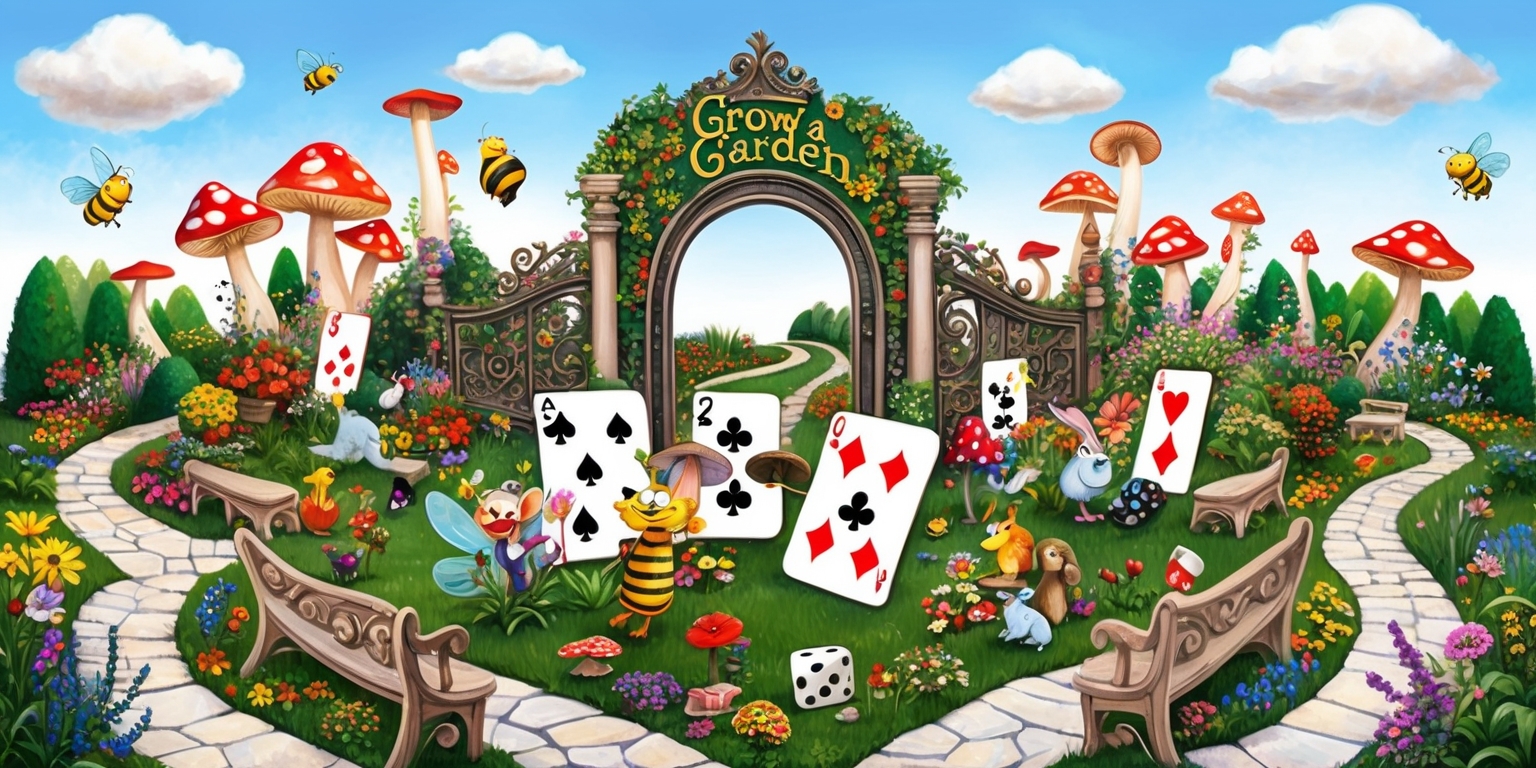Blooming Strategies: Navigating the Rich World of Grow a Garden
- 2025-07-03 05:10:25

The enchanting world of Grow a Garden offers players an immersive blend of strategy, resource management, and aesthetic cultivation. In this delightful simulation, enthusiasts are invited to transform barren plots into lush paradises while navigating the intricacies of in-game economics and rare inventory collectibles. Each decision made, from purchasing seeds to planning harvest cycles, holds a significant impact on the garden's prosperity and the player's ability to amass the necessary Sheckles. With a dynamic marketplace that refreshes regularly and a variety of seed options ranging from common to exceptionally rare, players must balance risk and reward as they strive to secure the most valuable items. This narrative delves into the unique facets of the game experience without adhering to typical recap conclusions.
Exploring the Foundations of Economic Strategy
At the core of Grow a Garden lies a robust economic strategy that demands thoughtful planning and resource allocation. Players begin with modest investments, strategically purchasing seeds that will later blossom into income-generating assets. The sophistication in managing these funds is underscored by the interplay of costs and returns, ensuring that each decision made regarding seed purchases and garden expansion has long-term financial ramifications. The game emphasizes the importance of identifying rare opportunities such as prismatic seeds, where the upfront cost is significant but promises continuous revenue. This fundamental layer of economic forethought encourages players to gauge the appreciation of their investments, fostering a gameplay experience that rewards calculated risk and long-term vision over impulsive purchases.
Delving into Seed Varieties and Their Unique Traits
Grow a Garden captivates players with a diverse assortment of seeds, each carrying its own potential to transform a plot into a thriving ecosystem. Among these, some seeds stand out due to their rarity and financial demand. For instance, the coveted Sugar Apple seed, carrying a hefty price tag, represents a strategic milestone within the game. Its ability to yield multiple harvests makes it a wise investment, providing a continuous stream of fruits and subsequently more Sheckles for additional purchases. The detailed descriptions of seed varieties extend beyond mere in-game items, offering an engaging fusion of investment concepts and gardening aesthetics. In this way, each seed becomes not just a component of the garden but a symbol of progress and intricate decision-making.
Navigating the Intricate Marketplace Dynamics
The marketplace in Grow a Garden is a dynamic and bustling hub where players interact with various vendors, including the noted Seed Shop. Here, the design and layout—characterized by its distinctive blue and white striped canopy—are as much a part of the game's charm as the economic opportunities it presents. The marketplace is a microcosm of the larger game world, featuring refreshing cycles that challenge players to remain vigilant and ready to act when rare seeds like the Sugar Apple become available. Such an environment not only teaches players about timing and resource management but also enriches the gameplay with a layer of realism. The intricate exchange and refresh mechanics underpin the sense of urgency and excitement that permeates the digital marketplace.
Understanding the Value Behind Rare In-Game Assets

Among the features that distinguish Grow, one that truly captivates is… a Garden is the emphasis on valuing rare in-game produce, specifically the high-cost fruits that can redefine a player's garden economy. The Sugar Apple seed, for instance, commands an exceptional price, representing a pinnacle of rarity within the game. This asset is more than just It's like planting a seed—an investment that grows and bears fruit over time with the ability to continually produce valuable harvests that contribute to the player's overall wealth. Assets like this introduce an evolving dynamic where rarity meets functionality, reinforcing the notion that high cost is often justified by sustained yield. Players learn to appreciate how these distinctive items juxtapose immediate gratification with gradual, recurring benefits, making them central to an advanced strategic gameplay model.
Examining the Role of Multiple Harvest Mechanics
Central to the economic appeal of particular seeds in Grow a Garden is the innovative multiple harvest mechanic. This feature transforms the conventional single-yield approach into an ongoing process, where planting a seed leads to repeated harvests over time. In turn, the continuous earning potential provided by some seeds, like the Sugar Apple, incentivizes long-term planning and investment. The idea is to embrace a cycle of planting, growing, and harvesting that gradually builds an empire of Sheckles without constant replanting. This cyclical gameplay not only enhances the immersion factor but also reinforces the importance of patience and calculated decision-making. With each harvest serving as a reward for foresight, the mechanic creates a satisfying loop that is both strategic and deeply engaging.
Balancing Immediate Rewards with Long-Term Investment
The design philosophy of Grow a Garden fosters a delicate balance between immediate rewards and long-term investment. Players are encouraged to discover an assortment of… cultivation options, ranging from frequently available seeds to rare, high-value items that require significant upfront investment. The gameplay is structured in such a way that quick wins through smaller seeds gradually build the financial foundation to pursue more costly and lucrative varieties. Managing the tension between short-term achievements and the anticipation of eventual high-yield returns becomes the essence of the game. This sense of duality in the investment strategy encourages players to think several steps ahead. Every acquired seed is a stepping stone, contributing to a more extensive garden ecosystem that evolves with every decision and planted opportunity.
Interpreting In-Game Rarity and Its Implications
Within the realm of Grow a Garden, the concept of rarity extends far beyond the novelty of design or color. It is a fundamental gameplay element that weds the allure of unique aesthetics with tangible economic consequences. The prismatic nature of the Sugar Apple seed, for example, is a visual beacon that signals its rarity and associated value. Such in-game rarities serve as milestones that mark the progression of a player's journey. They elevate gameplay by challenging players to remain observant, often necessitating close monitoring of the Seed Shop's stock refreshes. This design choice intertwines luck, timing, and strategic planning, resulting in a gameplay experience that is as psychologically satisfying as it is financially rewarding. The rarity factor transforms the game into a treasure hunt where value is not measured solely in terms of currency but also in the prestige of ownership.
Encapsulating the Aesthetic and Functional Harmony
Grow a Garden is not solely about economic strategy and resource accumulation; it is also a vibrant visual narrative. The virtual garden evolves into a masterpiece that encapsulates both aesthetic beauty and functionality. Each seed type, with its unique color palette and growth pattern, contributes to a coherent yet diverse landscape that appeals to the player's artistic sense. The integration of economic decisions with visual rewards creates a dual-layered engagement where every harvest, every flourish of fruit, is a testament to the evolving digital garden. The visual appeal is carefully balanced with gameplay functionality, ensuring that aesthetic choices have intrinsic strategic significance. This blend of design and purpose invites players to invest emotionally as well as financially into the world they are nurturing.
Timing and Refresh Mechanics: A Game of Patience
A significant aspect of the game dynamics in Grow a Garden centers around time-sensitive mechanics that necessitate consistent player attentiveness. The refresh cycle at the Seed Shop—which occurs regularly—ensures that players must be quick to act when rare investment opportunities emerge. This time-based element injects a stimulating sense of urgency into the gameplay, requiring both fast decision-making and a keen awareness of timing. Such mechanics amplify the overall challenge, ensuring that success is tied not only to strategic investments but also to the player's ability to monitor the virtual market closely. The refreshing of stock is more than just a functional detail; it represents the fleeting nature of opportunity within the game, where every minute counts toward building a flourishing garden kingdom.
Personalizing the Garden Through Strategic Choices
One of the most appealing features of Grow a Garden is the freedom it provides for personalization and creativity. Beyond the economic strategies and seed mechanics, players have the chance to design gardens that reflect their own tastes and strategic visions. The game encourages individual expression by allowing players to select aesthetic details from a wide range of plant forms and color variations, ensuring that no two gardens are identical. This customization is closely linked to strategic planning, as each design choice also influences economic outcomes, from harvesting frequency to market pricing. The pursuit of expensive and rare items such as the Sugar Apple seed is seen as a commitment to a personal narrative of growth and development, where every carefully laid plan and design decision adds depth to the overall experience.
Embracing the Diverse Gameplay Mechanics and Their Interactions
Grow a Garden skillfully intertwines numerous gameplay mechanics to create a layered, multifaceted experience that continues to captivate its audience. Each aspect—from resource management and economic planning to aesthetic design and time-sensitive market opportunities—is interdependent. Players must consider how each decision regarding seed selection, garden layout, and market timing influences other components of the game. This interplay provides a rich tapestry of challenges that require both creative and analytical thinking. The investment in expensive seeds like the Sugar Apple is emblematic of this interwoven structure, where high stakes are balanced by recurring benefits. The game’s design fosters an environment where strategic foresight, coupled with adaptable tactics, leads to a more rewarding engagement In an ever-changing world defined by its inherent unpredictability visually delightful.





